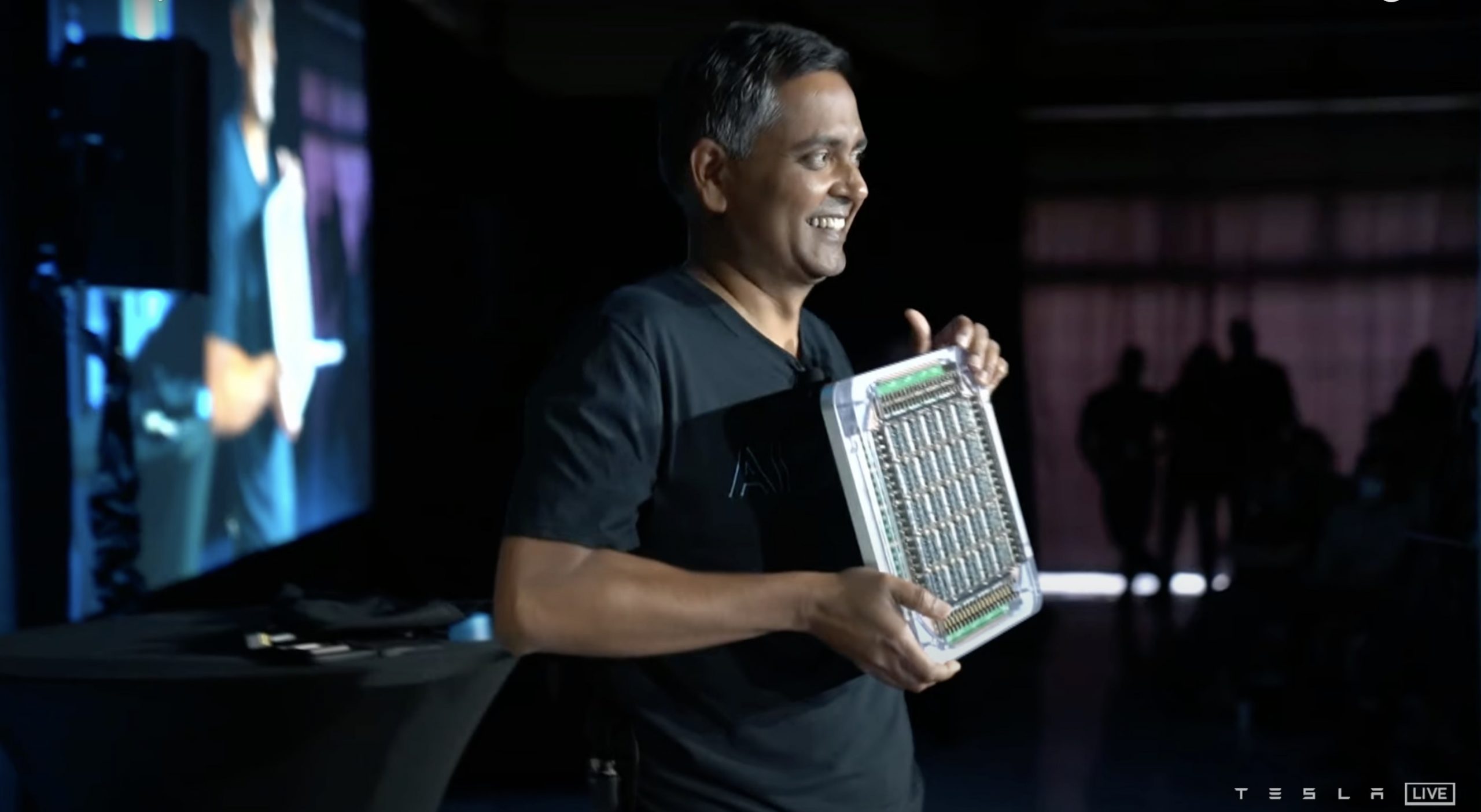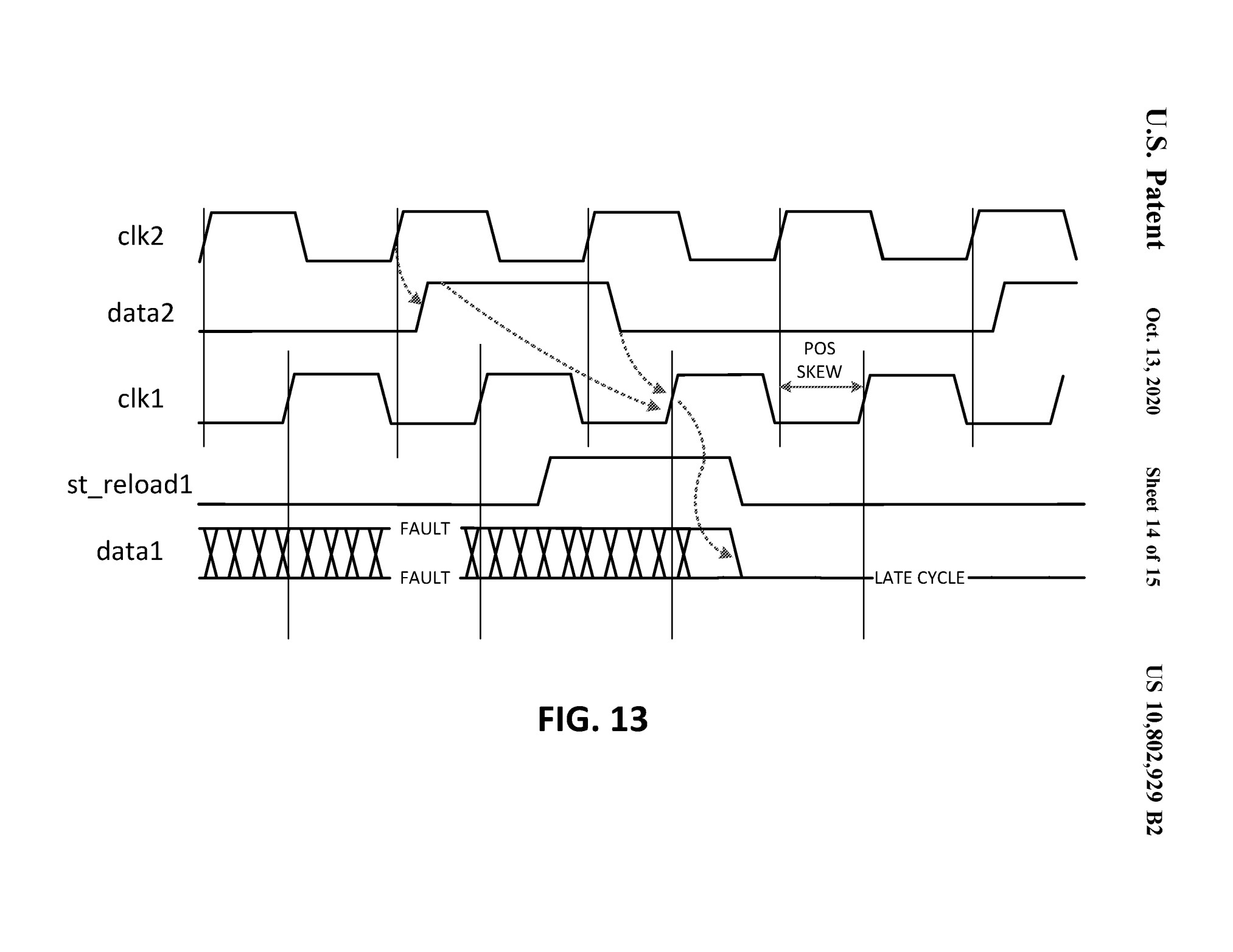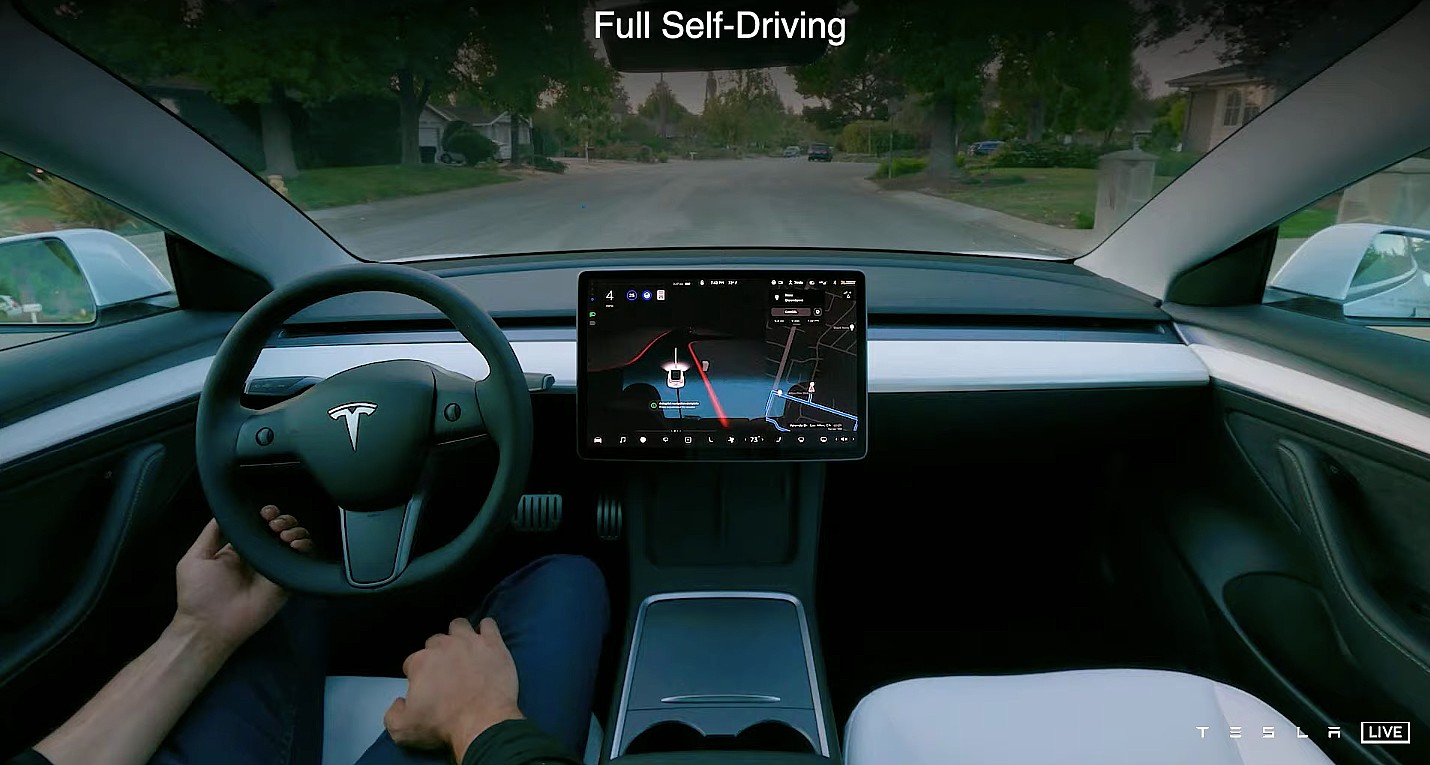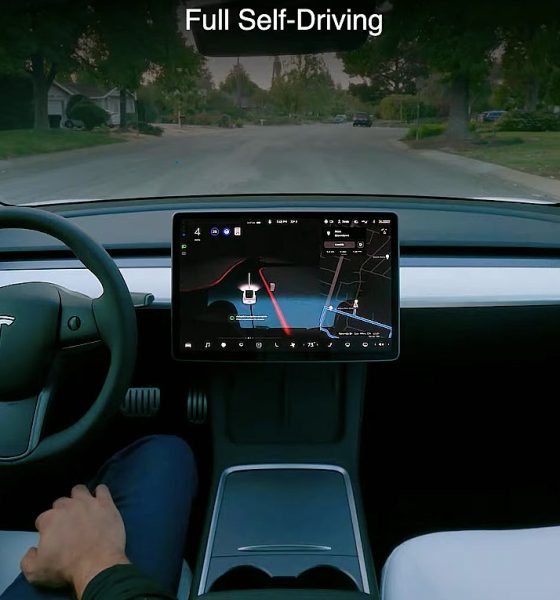Tesla has filed a new patent for “Parallel Processing System Runtime State Reload,” comprising of a system of three or more processors working in conjunction to effectively eliminate the possibility of hardware failure during the use of Autopilot or Full Self-Driving. The patent outlines a robust system of parallel processors that can operate in the event that one of them fails or experiences a runtime state error. “Should one of the parallel processors fail, at least one other processor would be available to continue performing autonomous driving functions,” the patent shows.
The patent was filed and published on August 26th and comes just a week after the company’s Artificial Intelligence Day event that was held last Thursday. Outlining a system of at least three processors operating in parallel, it is monitored by circuitry and can locate and identify if one of the three parallel-operating processors is having a runtime state error. The circuitry will then identify a second processor to switch to in the event of a runtime error, access the runtime state of the second processor, and load the runtime state of the second, operational processor into the first processor, which is experiencing a runtime error.
(Credit: Tesla)
Tesla describes the patent in detail:
“A system on a Chip (SoC) includes a plurality of processing systems arranged on a single integrated circuit. Each of these separate processing systems typically performs a corresponding set of processing functions. The separate processing systems typically interconnect via one or more communication bus structures that include an N-bit wide data bus (N, an integer greater than one). Some SoCs are deployed within systems that require high availability, e.g., financial processing systems, autonomous driving systems, medical processing systems, and air traffic control systems, among others. These parallel processing systems typically operate upon the same input data and include substantially identical processing components, e.g., pipeline structure, so that each of the parallel processing systems, when correctly operating, produces substantially the same output. Thus, should one of the parallel processors fail, at least one other processor would be available to continue performing autonomous driving functions.”
Technically speaking, the autonomous vehicle needs only one processor to function as described in an accurate fashion. However, these processors can be overloaded with data when loading into the Neural Network and could experience short-term and non-permanent operational errors. When this occurs, the system would then switch to one of the other processors for normal operation, with at least two backup processors in this patent, as it repeatedly mentions a series of three.
Tesla details its self-driving Supercomputer that will bring in the Dojo era
The second processor would then activate and load the runtime state into the first processor to make the primary processor chip operational once again:
“Thus, in order to overcome the above-described shortcomings, among other shortcomings, a parallel processing system of an embodiment of the present disclosure includes at least three processors operating in parallel, state monitoring circuitry, and state reload circuitry. The state monitoring circuitry couples to the at least three parallel processors and is configured to monitor runtime states of the at least three parallel processors and identify a first processor of the at least three parallel processors having at least one runtime state error. The state reload circuitry couples to the at least three parallel processors and is configured to select a second processor of the at least three parallel processors for state reload, access a runtime state of the second processor, and load the runtime state of the second processor into the first processor.”
The purpose of this patent is to continue system availability, even when the primary processor is experiencing functionality issues due to overuse. The two additional processors essentially act as “backup” and can determine whether autonomous driving systems are meant to be enabled if the first processor experiences an error. “With one particular example of this aspect, the parallel processing system supports autonomous driving and the respective sub-systems of the at least three parallel processors are safety sub-systems that determine whether autonomous driving is to be enabled.”
FIG. 13 is a timing diagram illustrating clocks of the circuits of FIGS. 8 and 10 according to one or more other described embodiments. As shown, the runtime state (data1) of first processor/first sub-system is determined to have at least one error. In response to this determination by the state monitoring/state reload circuitry, the signal st_reload1 is asserted to initiate the loading of runtime state (data2) from second processor/second sub-system into the first processor/first sub-system. With the embodiment of FIG. 13, a first clock (clk1) is used for the first processor/first sub-system and a second clock (clk1) is used for the second processor/second sub-system. There exists a positive skew between the first clock (clk1) and the second clock (clk2), resulting in a late cycle of the loading of the runtime state (data2) of the second processor/second sub-system into the first processor/sub-system, potentially resulting in errors in the runtime state reload process. (Credit: U.S. Patent Office)
It also appears that this patent aligns with Tesla CEO Elon Musk’s previous description of the Dojo self-driving Supercomputer, which was detailed at AI Day. To increase the accuracy and encourage the parallel operation of the processors, the system will utilize a clock input to calibrate the two processors, increasing the accuracy of the system.
Tesla has focused on accurate FSD operation and has revised its strategy on several occasions. After moving to a camera-only approach earlier this year for the Model 3 and Model Y, the company is experiencing more accurate FSD operation through the harmonized processing of its eight exterior cameras. The operation of internal processors, which are responsible for compiling, compressing, and sending data to the Neural Network, can fail temporarily, so the presence of backup processors to continue comprehending self-driving data is a positive idea.
The full patent is available below:
Tesla Patent Parallel Processing System Runtime State Reload by Joey Klender on Scribd

News
Tesla aims to combat common Full Self-Driving problem with new patent
Tesla writes in the patent that its autonomous and semi-autonomous vehicles are heavily reliant on camera systems to navigate and interact with their environment.

Tesla is aiming to combat a common Full Self-Driving problem with a new patent.
One issue with Tesla’s vision-based approach is that sunlight glare can become a troublesome element of everyday travel. Full Self-Driving is certainly an amazing technology, but there are still things Tesla is aiming to figure out with its development.
Unfortunately, it is extremely difficult to get around this issue, and even humans need ways to combat it when they’re driving, as we commonly use sunglasses or sun visors to give us better visibility.
Cameras obviously do not have these ways to fight sunglare, but a new patent Tesla recently had published aims to fight this through a “glare shield.”
Tesla writes in the patent that its autonomous and semi-autonomous vehicles are heavily reliant on camera systems to navigate and interact with their environment.

The ability to see surroundings is crucial for accurate performance, and glare is one element of interference that has yet to be confronted.
Tesla described the patent, which will utilize “a textured surface composed of an array of micro-cones, or cone-shaped formations, which serve to scatter incident light in various directions, thereby reducing glare and improving camera vision.”

The patent was first spotted by Not a Tesla App.
The design of the micro-cones is the first element of the puzzle to fight the excess glare. The patent says they are “optimized in size, angle, and orientation to minimize Total Hemispherical Reflectance (THR) and reflection penalty, enhancing the camera’s ability to accurately interpret visual data.”
Additionally, there is an electromechanical system for dynamic orientation adjustment, which will allow the micro-cones to move based on the angle of external light sources.
This is not the only thing Tesla is mulling to resolve issues with sunlight glare, as it has also worked on two other ways to combat the problem. One thing the company has discussed is a direct photon count.
CEO Elon Musk said during the Q2 Earnings Call:
“We use an approach which is direct photon count. When you see a processed image, so the image that goes from the sort of photon counter — the silicon photon counter — that then goes through a digital signal processor or image signal processor, that’s normally what happens. And then the image that you see looks all washed out, because if you point the camera at the sun, the post-processing of the photon counting washes things out.”
Future Hardware iterations, like Hardware 5 and Hardware 6, could also integrate better solutions for the sunglare issue, such as neutral density filters or heated lenses, aiming to solve glare more effectively.
Elon Musk
Delaware Supreme Court reinstates Elon Musk’s 2018 Tesla CEO pay package
The unanimous decision criticized the prior total rescission as “improper and inequitable,” arguing that it left Musk uncompensated for six years of transformative leadership at Tesla.

The Delaware Supreme Court has overturned a lower court ruling, reinstating Elon Musk’s 2018 compensation package originally valued at $56 billion but now worth approximately $139 billion due to Tesla’s soaring stock price.
The unanimous decision criticized the prior total rescission as “improper and inequitable,” arguing that it left Musk uncompensated for six years of transformative leadership at Tesla. Musk quickly celebrated the outcome on X, stating that he felt “vindicated.” He also shared his gratitude to TSLA shareholders.
Delaware Supreme Court makes a decision
In a 49-page ruling Friday, the Delaware Supreme Court reversed Chancellor Kathaleen McCormick’s 2024 decision that voided the 2018 package over alleged board conflicts and inadequate shareholder disclosures. The high court acknowledged varying views on liability but agreed rescission was excessive, stating it “leaves Musk uncompensated for his time and efforts over a period of six years.”
The 2018 plan granted Musk options on about 304 million shares upon hitting aggressive milestones, all of which were achieved ahead of time. Shareholders overwhelmingly approved it initially in 2018 and ratified it once again in 2024 after the Delaware lower court struck it down. The case against Musk’s 2018 pay package was filed by plaintiff Richard Tornetta, who held just nine shares when the compensation plan was approved.
A hard-fought victory
As noted in a Reuters report, Tesla’s win avoids a potential $26 billion earnings hit from replacing the award at current prices. Tesla, now Texas-incorporated, had hedged with interim plans, including a November 2025 shareholder-approved package potentially worth $878 billion tied to Robotaxi and Optimus goals and other extremely aggressive operational milestones.
The saga surrounding Elon Musk’s 2018 pay package ultimately damaged Delaware’s corporate appeal, prompting a number of high-profile firms, such as Dropbox, Roblox, Trade Desk, and Coinbase, to follow Tesla’s exodus out of the state. What added more fuel to the issue was the fact that Tornetta’s legal team, following the lower court’s 2024 decision, demanded a fee request of more than $5.1 billion worth of TSLA stock, which was equal to an hourly rate of over $200,000.
Delaware Supreme Court Elon Musk 2018 Pay Package by Simon Alvarez
News
Tesla Cybercab tests are going on overdrive with production-ready units
Tesla is ramping its real-world tests of the Cybercab, with multiple sightings of the vehicle being reported across social media this week.

Tesla is ramping its real-world tests of the Cybercab, with multiple sightings of the autonomous two-seater being reported across social media this week. Based on videos of the vehicle that have been shared online, it appears that Cybercab tests are underway across multiple states.
Recent Cybercab sightings
Reports of Cybercab tests have ramped this week, with a vehicle that looked like a production-ready prototype being spotted at Apple’s Visitor Center in California. The vehicle in this sighting was interesting as it was equipped with a steering wheel. The vehicle also featured some changes to the design of its brake lights.
The Cybercab was also filmed testing at the Fremont factory’s test track, which also seemed to involve a vehicle that looked production-ready. This also seemed to be the case for a Cybercab that was spotted in Austin, Texas, which happened to be undergoing real-world tests. Overall, these sightings suggest that Cybercab testing is fully underway, and the vehicle is really moving towards production.
Production design all but finalized?
Recently, a near-production-ready Cybercab was showcased at Tesla’s Santana Row showroom in San Jose. The vehicle was equipped with frameless windows, dual windshield wipers, powered butterfly door struts, an extended front splitter, an updated lightbar, new wheel covers, and a license plate bracket. Interior updates include redesigned dash/door panels, refined seats with center cupholders, updated carpet, and what appeared to be improved legroom.
There seems to be a pretty good chance that the Cybercab’s design has been all but finalized, at least considering Elon Musk’s comments at the 2025 Annual Shareholder Meeting. During the event, Musk confirmed that the vehicle will enter production around April 2026, and its production targets will be quite ambitious.










